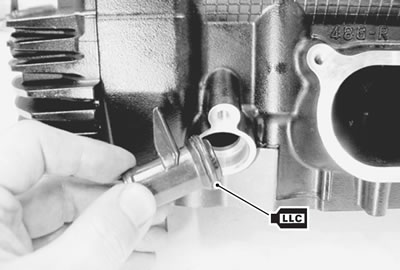Cam chain tensioner
- Remove the cam chain tensioner 1.
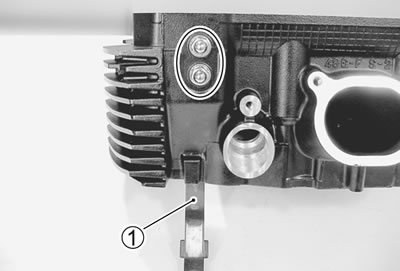
Cylinder head distortion
- Decarbonize the combustion chambers.
- Check the gasketed surface of the cylinder head for distortion with a straightedge and thickness gauge, taking a clearance reading at several places indicated.
- If the largest reading at any position of the straightedge exceeds the limit, replace the cylinder head.
Cylinder head distortion:
- Service Limit: 0.05 mm (0.002 in)
- 09900-20803: Thickness gauge
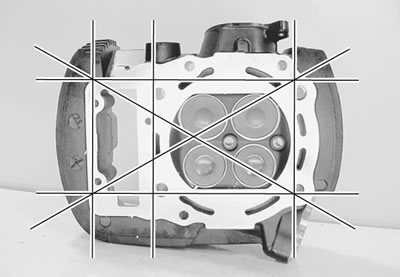
Valve and valve spring disassembly
- Remove the tappet 1 and shim 2 by fingers or magnetic hand.
Caution: Identify the position of each removed part.
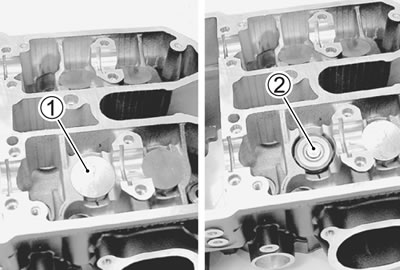
- Install the special tool between the valve spring and cylinder head.
09919-28610: Sleeve protector.
Caution: To prevent damage of the tappet sliding surface with the valve lifter attachment, use a protector.
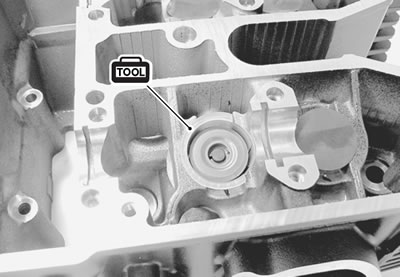
- Using the special tools, compress the valve spring and remove the two cotter halves 3 from the valve stem.
- 09916-14510: Valve lifter
- 09916-14910: Valve lifter attachment
- 09916-84511: Tweezers
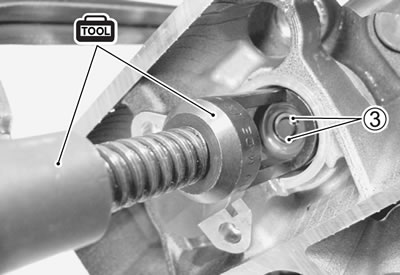
- Remove the valve spring retainer 4 and valve spring 5.
- Pull out the valve 6 from the combustion chamber side.
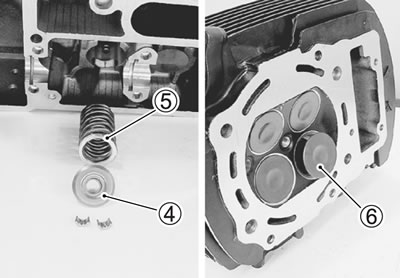
- Remove the oil seal 7 and spring seat 8.
Caution: Do not reuse the removed oil seal.
- Remove the other valves in the same manner as described previously.
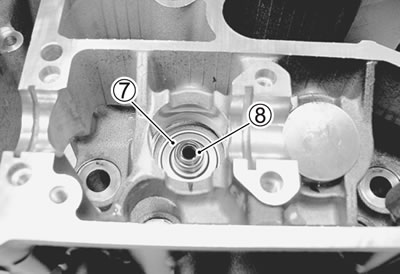
Valve stem runout
- Support the valve using V-blocks and check its runout using the dial gauge as shown.
- If the runout exceeds the service limit, replace the valve.
Valve stem runout:
- Service Limit: 0.05 mm (0.002 in)
- 09900-20607: Dial gauge (1/100 mm)
- 09900-20701: Magnetic stand
- 09900-21304: V-block set (100 mm)
Caution: Be careful not to damage the valve and valve stem when handling it.

Valve head radial runout
- Place the dial gauge at a right angle to the valve head face and measure the valve head radial runout.
- If it measures more than the service limit, replace the valve.
Valve head radial runout:
- Service Limit: 0.03 mm (0.001 in)
- 09900-20607: Dial gauge (1/100 mm)
- 09900-20701: Magnetic stand
- 09900-21304: V-block set (100 mm)
Caution: Be careful not to damage the valve and valve stem when handling it.

Valve stem and valve face wear condition
- Visually inspect each valve stem and valve face for wear and pitting. If it is worn or damaged, replace the valve with a new one.
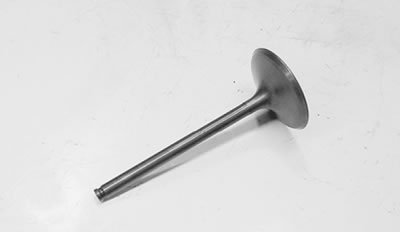
Valve stem deflection
- Lift the valve about 10 mm (0.39 in) from the valve seat.
- Measure the valve stem deflection in two directions, perpendicular to each other, by positioning the dial gauge as shown.
- If the deflection measured exceeds the limit, then determine whether the valve or the guide should be replaced with a new one.
Valve stem deflection (IN. & EX.):
- Service Limit: 0.35 mm (0.014 in)
- 09900-20607: Dial gauge (1/100 mm)
- 09900-20701: Magnetic stand
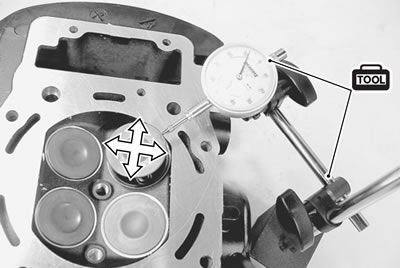
Valve stem wear
- If the valve stem is worn down to the limit, as measured with a micrometer, replace the valve.
- If the stem is within the limit, then replace the guide.
- After replacing valve or guide, be sure to recheck the deflection.
Valve stem O.D.:
- Standard (IN.) : 5.975 - 5.990 mm (0.2352 - 0.2358 in) (EX.): 5.955 - 5.970 mm (0.2344 - 0.2350 in)
- 09900-20205: Micrometer (0 - 25 mm)
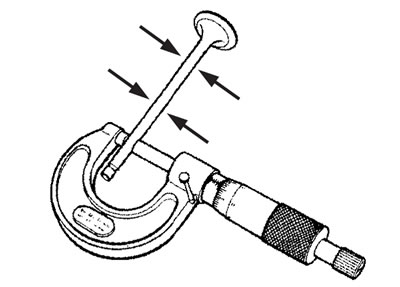
Note: If valve guides have to be removed for replacement after inspecting related parts, carry out the steps shown in valve guide servicing. (3-36)
Valve guide servicing
- Using the valve guide remover, drive the valve guide out toward the intake or exhaust camshaft side.
- 09916-46020: Valve guide remover/installer
Note:
- Discard the removed valve guide subassemblies.
- Only oversized valve guides are available as replacement parts. (Part No. 11115-65J00-001)
- Cool down the new valve guides in a freezer for about one hour and heat the cylinder head to 100 - 150°C (212 - 302°F) with a hot plate.

Caution: Do not use a burner to heat the valve guide hole to prevent cylinder head distortion.
- Apply engine oil to the valve guide hole.
- Drive the valve guide into the hole using the valve guide installer 1 and attachment 2.
- 09916-46020: Valve guide installer/remover 1
- 09916-44940: Attachment 2

Note: Install the valve guide until the attachment contacts the cylinder head 3.
Caution: Failure to oil the valve guide hole before driving the new guide into place may result in a damaged guide or head.
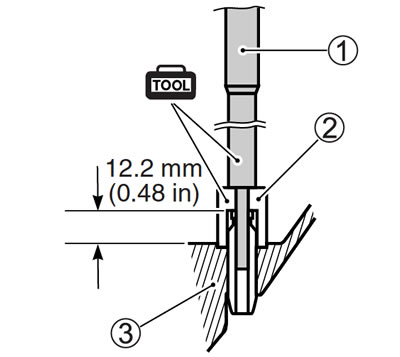
- After installing the valve guides, re-finish their guiding bores using the reamer.
- Clean and oil the guides after reaming.
- 09916-37810: Valve guide reamer
- 09916-34542: Reamer handle
Note:
- Be sure to cool down the cylinder head to ambient air temperature.
- Insert the reamer from the combustion chamber and always turn the reamer handle clockwise.
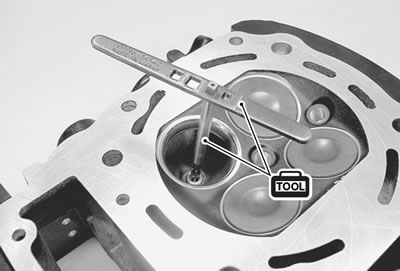
Valve seat width inspection
- Visually check for valve seat width on each valve face.
- If the valve face has worn abnormally, replace the valve.
- Coat the valve seat with a red lead (Prussian Blue) and set the valve in place. Rotate the valve with light pressure.
- Check that the transferred red lead (blue) on the valve face is uniform all around and in center of the valve face.
09916-10911: Valve lapper set
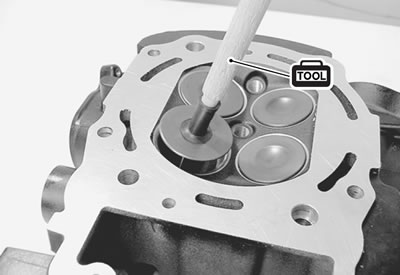
- If the seat width W measured exceeds the standard value or seat width is not uniform, reface the seat using the seat cutter.
Valve seat width W:
Standard: (IN.): 1.1 - 1.3 mm (0.043 - 0.051 in) (EX.): 1.4 - 1.6 mm (0.055 - 0.063 in)
If the valve seat is out of specification, re-cut the seat.
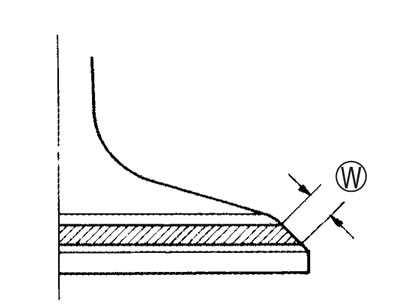
Valve seat servicing
- The valve seats 1 for both the intake valve 2 and exhaust valve 3 are machined to three different angles. The seat contact surface is cut at 45°.
| INTAKE | EXHAUST | |
| Seat angle | 15°, 45°, 60° | ← |
| Seat width | 1.1 - 1.3 mm (0.043 - 0.051 in) | 1.4 - 1.6 mm (0.055 - 0.063 in) |
| Valve diameter | 42 mm (1.65 in) | 38 mm (1.50 in) |
| Valve guide I.D. | 6.000 - 6.012 mm (0.2362 - 0.2377 in) | ← |
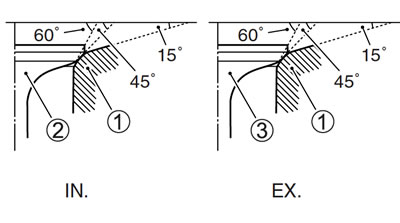
Caution:
- The valve seat contact area must be inspected after each cut.
- Do not use lapping compound after the final cut is made. The finished valve seat should have a velvety smooth finish but not a highly polished or shiny finish. This will provide a soft surface for the final seating of the valve which will occur during the first few seconds of engine operation.
Note: After servicing the valve seats, be sure to check the valve clearance after the cylinder head has been reinstalled. (2-8)
- Clean and assemble the head and valve components. Fill the intake and exhaust ports with gasoline to check for leaks.
- If any leaks occur, inspect the valve seat and face for burrs or other things that could prevent the valve from sealing.
Warning: Always use extreme caution when handling gasoline.
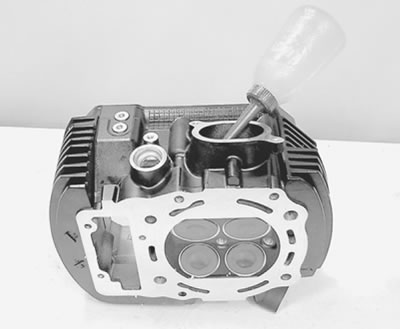
Valve spring
The force of the coil spring keeps the valve seat tight. Weakened spring results in reduced engine power output, and often accounts for the chattering noise coming from the valve mechanism.
- Check the valve spring for proper strength by measuring its free length and also by the force required to compress it.
- If the spring length is less than the service limit, or if the force required to compress the spring does not fall within the range specified, replace the spring.
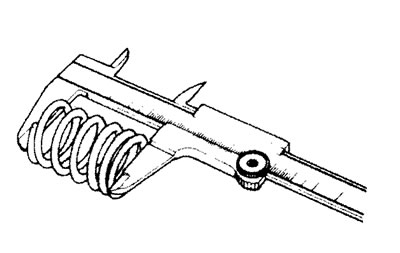
Valve spring free length:
- Service limit: (IN. & EX.): 40.5 mm (1.60 in)
- 09900-20102: Vernier calipers
- Valve spring tension (IN. & EX.):
- Standard: 197 - 227 N (20.1 - 23.1 kgf/36.6 mm, 44.3 - 51.0 lbs/1.44 in)
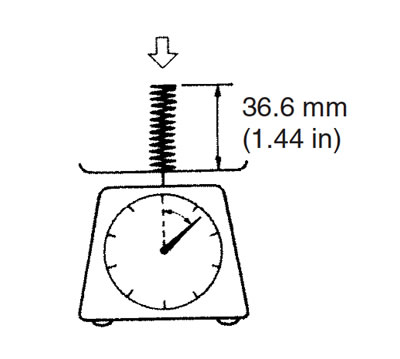
Valve and valve spring reassembly
- Install the valve spring seat 1.
- Apply MOLYBDENUM OIL SOLUTION to the oil seal 2, and press-fit it into position.
Molybdenum oil solution
Caution: Do not reuse the removed oil seal.
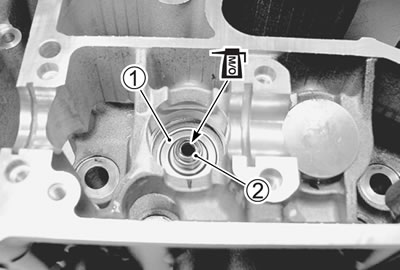
- Insert the valve, with its stem coated with MOLYBDENUM OIL SOLUTION all around and along the full stem length without any break.
Caution: When inserting the valve, take care not to damage the lip of the oil seal.
Molybdenum oil solution

- Install the valve spring with the small-pitch portion А facing cylinder head.
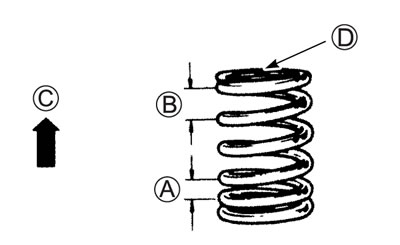
B. Large-pitch portion; C. UPWARD; D. Paint
- Put on the valve spring retainer 3, and using the valve lifter and protector 4, press down the spring, fit the cotter halves to the stem end, and release the lifter to allow the cotter 5 to wedge in between retainer and stem.
- 09916-14510: Valve lifter
- 09916-14910: Valve lifter attachment
- 09916-84511: Tweezers
- 09919-28610: Sleeve protector

- Be sure that the rounded lip E of the cotter fits snugly into the groove F in the stem end.
- Install the other valves and springs in the same manner as described previously.
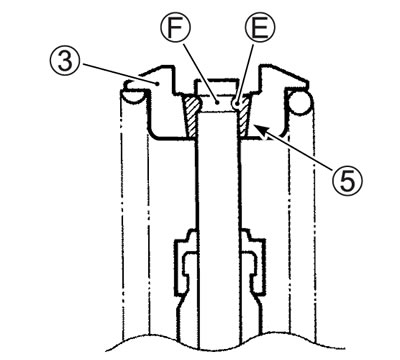
3. Valve spring retainer; 5. Cotter
Caution: Be sure to restore each spring and valve to their original positions.
Caution: Be careful not to damage the valve and valve stem when handling it.
- Install the tappet shims and the tappets to their original positions.
Note:
- Apply engine oil to the stem end, shim and tappet before fitting them.
- When seating the tappet shim, be sure the figure printed surface faces the tappet.
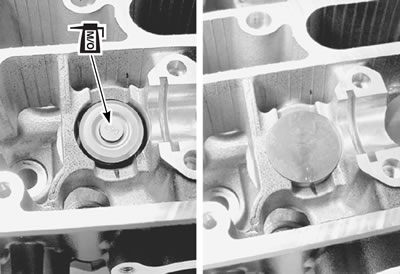
Cam chain tensioner
- Inspect the cam chain tensioner for damage. If any damage are found, replace the cam chain tensioner with a new one.

- Install the cam chain tensioner 1, washers 2 and nuts 3.
- Tighten the cam chain tensioner nuts to the specified torque.
Cam chain tensioner nut: 10 Nm (1.0 kgf·m, 7.0 lb·ft)
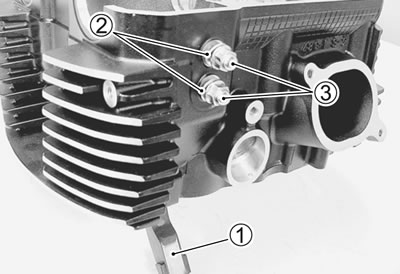
Water jacket plug
- Remove the water jacket plug 1.
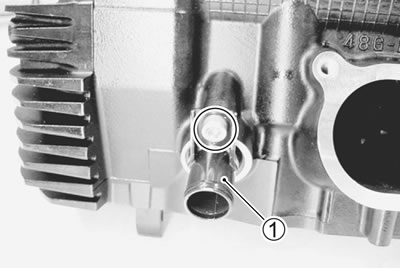
- Apply engine coolant to the new O-ring and install the water jacket plug.
Caution: Use a new O-ring to prevent engine coolant leakage.
